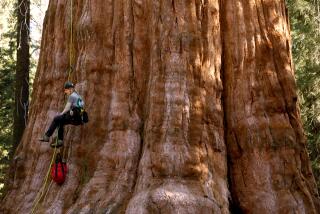The Triumph of an Ordinary Tree
- Share via
Trees are the tallest, the most massive and the longest-lived creatures on Earth. But oaks hold none of the records. The oak is not the tallest tree. That distinction belongs to a redwood in Northern California, which tops out at about 368 feet, easily twice as tall as the tallest oak. Neither is the oak the most massive tree. That honor is held, if you wish, by the General Sherman sequoia in Kings Canyon National Park, weighing in at about 2,000 tons, though if you are thinking genetically, the record may instead be held by a clonal aspen grove in Utah that covers more than 106 acres. The oak is not the oldest tree. The bristlecone pine holds that record, at something in excess of 4,867 years. The oak is not the strongest tree. Ebony, teak and many other tropical woods have greater strength under tension, compression and shear forces. And the oak is far from the fastest-growing tree. There is a species of albizia in Malaysia that can grow more than an inch each day; an oak is lucky to do a foot each year. Any old maple, pine, poplar or eucalyptus can easily outrun the oak.
So what is so special about oaks? Nothing at all.
Then why are oaks everywhere? Why can you go from Massachusetts to Mexico City, from the Yucatan to British Columbia, from the vale of Kashmir to Cadiz, from the Atlas Mountains to the fjords of Norway, from Borneo to Hokkaido, and never run out of abundant, native oak?
Exactly because oaks are not special. Blue jays feed on the oak and in return carry acorns far afield. Some oaks graft roots beneath the ground, so the grove offers mutual support to its members. Oaks themselves hybridize freely, so a new habitat is likely to find an altered oak to live there.
Consider, by contrast, the chambered nautilus, that outsized, tiger-striped mollusk that moves from room to room each year inside its growing shell. The nautilus was once part of a diverse genus that could live all over the ocean, but then it began to specialize, until at last it can live only in one tiny niche.
But the oaks have never sought a niche. “Oaks have been so successful exactly because there is no reason that they are,” Cornell University taxonomist Kevin Nixon said. “Restricted distribution happens because there is just one reason for a creature’s success.” This is a tantalizing idea. The persistent, the common, the various, the adaptable is valuable in itself. The oak’s distinction is its insistence and its flexibility. It specializes in not specializing.
And indeed, although the biggest, fastest-growing, strongest or oldest of trees attract their share of awe and appreciation, no tree has been anywhere near as storied or as useful around the world as the oak.
In the Bible, Abraham met the angels under an oak. The oaks of Dodona in ancient Greece spoke oracles. The oak carried Vikings to Vinland, and with oak ships, the new European nations knit the globe. Shakyamuni, the name of the historical Buddha, means “the sage of the oak tree people.” The word “druid” means “possessing oak knowledge.”
The tree champions are well described as niche holders: The giant redwood can survive only on a cool, fogbound band of temperate coast. The ancient bristlecone pine grows only on one high mountain ridge, where no pest can survive long enough to attack it. Ebony needs great heat, lots of water and little variation in temperature to make its strong, flexible, durable wood. None of these record trees thrive in the middle of the world, throughout the temperate zone, where the unpredictable is commonplace.
A great oak story concerns Milo of Croton. He was known as the strongest man in ancient Greece. Armies were said to have fled when they saw him coming. When he was hungry, he killed an ox with a single blow and ate it on the spot. One evening, Milo was out walking in the woods when he saw an old oak. The woodcutters had got their wedges into a crack in the tree but had left the rest of the work for the next day.
Milo decided he would finish the job. He thrust his massive hands into the crack to pull the tree apart. The wedges fell out. The trunk clapped shut on his hands, and he could not pull them out. Later that night, the wolves found him.
The biggest, best and fastest met his end because he thought himself more capable than the common oak, one of thousands just like it stretching as far as the eye can see.
More to Read
Sign up for The Wild
We’ll help you find the best places to hike, bike and run, as well as the perfect silent spots for meditation and yoga.
You may occasionally receive promotional content from the Los Angeles Times.





